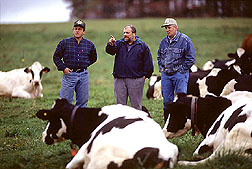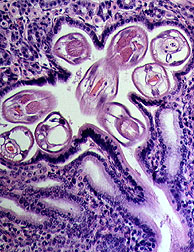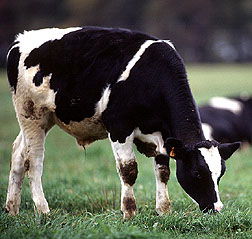An Ounce of Prevention Equals Pounds of Milk
|
|
This coming spring, Pennsylvania dairy farmer Larry Lohr will treat his cows just once with a wormer. That should hold them until the end of the grazing season, when he brings them back in from pasture, says Agricultural Research Service parasitologist Lou Gasbarre. Then, Gasbarre recommends one more treatment . . . just for safe measure.
Even with the extra treatment, it will be three fewer than Lohr gave his cows in 1996 to battle the brown stomach worm--Ostertagia ostertagi.
This roundworm makes its home in the stomachs of dairy and beef cattle in temperate regions worldwide. Ostertagia accounts for 80 to 90 percent of the worm problem in U.S. beef and dairy cattle, costing the industry more than $2 billion annually. The most common estimates put producer costs at about $20 per animal per year, says Gasbarre, who is with ARS' Immunology and Disease Resistance Laboratory in Beltsville, Maryland.
Thanks to Gasbarre's recommendation to take a prophylactic approach to the worm, Lohr's cows kept a 3-pounds-per-day increase in milk production last summer—that's 6 percent more milk—compared to the same months in 1995 and 1996. And they had "significantly higher body weights," says Lohr.
Those increases in milk production and body weight also had an environmental benefit. Nitrogen that went into the increased animal production wasn't excreted in urine onto the pasture, where a large portion of it would have been susceptible to leaching into the groundwater.
Lohr is among the first of a growing breed of dairy producers trying to increase their net income by letting cows feed themselves during the growing season rather than cut, dry, and store the feed and then serve it to them later. Since he began pasturing his cows 12 years ago, Lohr says he has had "real good success. My annual feed costs dropped about $150 per cow." And it has increased efficiency so much he has been able to increase his herd from 45 to 100 cows.
When Lohr set up the intensive rotational grazing system, no one advised him how to keep the brown stomach worm from nibbling into his profits. Although he routinely treated his cows with a wormer during the grazing season, milk production increased after the treatments but then dropped again, he says.
|
|
Lohr suspected that worms might be causing this roller coaster effect. He mentioned the problem at a meeting at the Pennsylvania State University Center for Grazing Research and Education, where he represents dairy producers. Fellow center member, ARS soil scientist Bill Stout, contacted Gasbarre about the problem.
Together, the two scientists applied for and received a grant from the Sustainable Agriculture Research and Education Program, known as SARE, for a 3-year study of Lohr's farm. Funded by USDA to encourage low-input production, SARE is administered by the University of Vermont for projects in the Northeast.
During the 1995 and 1996 grazing seasons, Gasbarre observed Lohr's operation. He also mixed worm-free calves raised at the Beltsville center in with Lohr's cows in order to measure infection rates. Lohr has 19 fenced, 1-1/2-acre paddocks on which he rotates the cows daily.
With this scheme, the animals eat the grass when it's most nutritious. But it also fits into the worm's life cycle perfectly for keeping infectious larvae at high levels, says Gasbarre.
"The eggs take 10 to 14 days to become infectious after they are passed in the feces. Normally, cows avoid grazing near feces, where the parasites are heaviest. But in heavily grazed paddocks, like this farm, cows eat everything," he says. "There are no tufts left."
With a 19-day rotation, the cows were grazing each paddock shortly after the eggs that had been deposited in the previous rotation developed into infectious larvae. The animals kept becoming reinfected until the worms built up to a critical level—dropping milk production and animal weights.
Gasbarre says some scientists and veterinarians are not convinced that worms reduce milk production, animal weight, or reproduction in females. They think cattle have enough immunity to suppress infection.
But the evidence from Lohr's farm belies that notion.
Gasbarre recommended that Lohr treat his cows in the spring right after they had made their first rotation through all 19 paddocks. That way, any larvae that survived the winter would be picked up and killed. "The cows act as big vacuum cleaners," he says.
"They don't pass eggs for 17 to 20 days after they've been infected. By treating them after 19 days in contaminated paddocks, it kills off the worms before the eggs can pass out and recontaminate."
And the theory worked, judging by the worm-free calves that Gasbarre mixed in with Lohr's herd throughout the study.
|
|
Before treatment, the calves passed the same number of eggs as in the previous year. By the end of August, only about 10 percent of the calves had any eggs in their feces at all. And these had only one or two, says Gasbarre.
"Instead of a roller coaster effect," says Lohr, "we've evened out our milk production."
In 1995, Lohr wormed his cows five times. Last year, under the prophylactic approach, he wormed them three times. This year, it will drop to two treatments—one in the spring, after the first 19-day rotation, and another at the end of the grazing season.
Lohr will have to continue treating his cows each spring to retard larvae build-up, Gasbarre says. But pasture levels are so low now that the second treatment is just for insurance. "It's more expensive to clean up the problem than to prevent it.
"We don't want the animals to never see a parasite," he adds. "They need to build up some exposure to stimulate their immune systems. But you want to keep the exposure below a level where the parasites overwhelm the immune system."
Gasbarre emphasizes the importance of considering health issues when setting up animal management programs.
"Lohr would not have gotten to this point if he had been advised to manage his pastures for parasites—using prophylaxis," he says.
He recommends that producers treat their animals once, then watch the weather and give follow-up treatments accordingly.
"The larvae thrive in cool, wet weather. A prolonged dry spell will slow them down, especially combined with hot weather," says Gasbarre.
As part of the funding for this study, the Northeast SARE review committee wanted to know how many other producers in the region felt they had a worm problem and what management practices might be contributing to it. Stout and Gasbarre developed a questionnaire that was sent to 2,000 livestock producers—from Maine to Maryland.
Nearly 800 responded, and the researchers are still analyzing the data. Preliminary indications are that 40 percent of the respondents didn't know if worms were a problem on their farm. One-third reported worms to be a moderate problem, while a little more than one-quarter didn't think they had a worm problem. Lohr is now among those without a problem.
"It proves the system will work if done properly," he says. "If farmers have a problem, they should go after an answer."—By Judy McBride AgriculturalResearch Service Information Staff, 6303 Ivy Lane, Greenbelt, Maryland 20770, phone (301) 344-2861.
Louis C. Gasbarre is at the USDA-ARS Immunology and Disease Resistance Laboratory, Bldg. 1002, 10300 Baltimore Ave., Beltsville, MD 20705-2350; phone (301) 504-8509, fax (301) 504-5306.
William L. Stout is at the USDA-ARS Pasture Systems and Watershed Management Research Laboratory, Curtin Rd., University Park, PA 16802-3702; phone (814) 863-0947, fax (814) 863-0935.
"An Ounce of Prevention Equals Pounds of Milk" was published in the January 1998 issue of Agricultural Research magazine. Click here to see this issue's table of contents.









